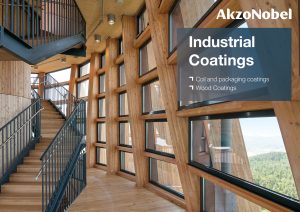More news
- Focus on industrial: Powering the energy industry during extreme heat
- Focus on powder coatings: The coatings industry’s transition to PFAS/PTFE-free solut...
- “We see sustainability as a purpose, as a reason for doing business” – P...
- Focus on industrial: High-performance coating protects tanks at biopolymer production plan...
- Focus on powder coatings: Novel high-speed crosslinking technology

PPCJ spoke to AkzoNobel’s Kaj van Alem, Global Segment Director, Wood Finishes, about the latest developments and most pressing trends in the industrial coatings sector
Q. Can you explain what qualifies as an ‘industrial coating’ and the various different substrates the coatings may have to adhere to?
A. AkzoNobel’s Industrial Coatings business focuses on four main segments, providing colour and protection in countless situations. Our complete range of coil and extrusion solutions for the metal construction industry includes residential, agricultural and commercial applications.
Our coatings are used in the packaging industry for beverages, food, closures and general canning and we have an extensive range of industrial wood finishes to protect and enhance, primarily for the building product (windows, doors and cladding), flooring, cabinetry and furniture industries.
Lastly, we supply our innovative industrial wood adhesives (a bonding solution) to the construction, flooring and furniture sectors. The substrates to which industrial coatings adhere vary from wood and coil to metal can packaging.
Q. What are the main priorities/requirements for coatings used on industrial finishes?
A. Industrial coatings play a critical role in protecting surfaces against corrosion, abrasion, weathering and other environmental factors. The main priorities and requirements for coatings used on industrial finishes include durability, corrosion resistance, adhesion, chemical resistance, flexibility and regulatory compliance.
Q. What, in your opinion, is the greatest challenge when creating an industrial coating?
A. The development of industrial coatings presents several challenges, with the primary one being achieving a balance between performance, sustainability, regulatory requirements and application efficiency.
This challenge involves formulating coatings with superior properties while minimising environmental impact and meeting regulatory requirements, and innovating sustainable (curing) technologies that reduce carbon emissions without compromising performance.
Optimising the application and curing processes to enhance efficiency and energy efficiency and reduce waste is crucial, as is adapting to evolving industry demands for aesthetics and functionality. AkzoNobel remains committed to addressing these challenges through research, innovation, and collaboration with customers to deliver high-performance coatings that meet and exceed industry needs while advancing sustainability and compliance goals.
READ MORE:
Focus on sustainability: AkzoNobel joins major innovation programme to solve societal challenges
Q. What are the most prominent trends in this sector and what are your customers’ main concerns when it comes to a coating for industrial finishes?
A. Customers demand design, style, cost and efficiency gains and have a growing interest in more eco-friendly options and increased durability. Furthermore, legislation in various areas in increasing.
For the Packaging sector, the most prominent trend is that the industry is moving away from bisphenol-based coatings. For decades, BPA based epoxy resins have been used to manufacture coatings for the protection of metal can packaging. In recent years, BPA and the class of bisphenols have become a concern for our customers, as regulatory scrutiny became more intense. We are among those in the industry that have developed new solutions free of BPA and bisphenols, including metal can packaging.
AkzoNobel has introduced a groundbreaking the BPx-NI* (free of intentionally added bisphenols like bisphenol A) internal coating for beverage can ends – which complies with US Food and Drug Administration (FDA) and EU regulations.
In November 2023, Our Packaging Coatings business has also launched the first two products in the new AccelstyleTM range. Designed for the exterior of conventional two-piece aluminium beverage cans, both are free from bisphenols, styrene and PFAS (per- and polyfluoroalkyl substances).
Regardless of the challenges, it’s our opinion that metal can packaging coating technology has advanced to the point where bisphenols of any kind are no longer required to create safe coatings.
AkzoNobel’s approach to the bisphenol transition of metal cans prioritises consumer safety and sustainability with responsible material substitutions, while taking care to limit disruption to the value chain. The company is working closely with customers to help accelerate the adoption of bisphenol alternatives.
The new products can be seamlessly introduced into existing production processes, allowing can makers to transition to coatings that are free from certain important materials of concern, while remaining as commercially viable as possible.
Customers are also emphasising the need for protection against corrosion and harsh conditions. Performance under specific industry conditions, ease of application, and cost-effectiveness are key considerations. Compliance with health and safety standards, along with the availability of robust technical and practicality of industrial coatings.

Q. How is AI and other technological advancements impacting coatings manufacturing at the moment?
A. We are utilising the newest AI technologies to search and replace some materials in our paint formulations by more sustainable, more environmentally friendly materials. Research into new materials is being done already for many decades based on “traditional research experiments” with “real materials. The newest tools might have the potential to simulate such experiment digitally as well.
Advantages are: 1) number of experiments can be scaled up enormously; 2) it could give us more insights into actual reaction mechanisms on a molecular scale; and 3) we can run experiments with materials that do not even exist.
Q. Sustainability is a huge topic throughout the coatings industry. Is it as prominent in the industrial sector, which relies so much on durability and performance?
A. As a company, we’re fully focused on innovating with, and for, customers, and continue to play a progressive role in energising entire industries to advance towards a more sustainable future. Sustainability has become a significant and increasingly prominent topic within the entire coatings industry, also in the industrial coatings sector where durability, process efficiency, circular materials and improved energy efficiency are critical considerations.
While the need for coatings strong enough to withstand harsh industrial conditions remains paramount, there is a noticeable trend towards more sustainable formulations and lowering carbon footprint.
READ MORE:
It’s a wrap! Middle East Coatings Show welcomes record number of visitors to Cairo
Q. Many industrial coatings are still solvent-based, due to the highly durable requirements. What ‘green’ credentials are you able to incorporate into your coatings for industrial finishes?
A. Our coatings solutions offer superior protection, durability and aesthetics, backed by rigorous testing and industry-leading standards.
We actively collaborate with industries to drive progress and advancements, also on reducing solvent emissions and moving to waterborne product. Our expertise, combined with a deep understanding of market trends, positions us as a catalyst for success in a rapidly evolving industrial and legislative landscape.
We’re always looking for innovative ways to reduce our own and our customers’ carbon emissions.
- AkzoNobel’s Coil and Extrusion Coatings business has signed a strategic agreement with China’s Wuxi El Pont Radiation Technology Co., Ltd to develop a pioneering process that uses electron beams to cure coatings on metal substrates.
- E-beam technology is a fast-growing scientific field and could offer significant advantages over conventional thermal curing methods, such as lower energy consumption, increased productivity with higher quality and reduced environmental impact. The process itself cures coatings by using a directed stream of electrons to deliver the energy required to form the final film.
- AkzoNobel’s coatings enable waste reduction, utilise less or recycled materials, and offer longer-lasting performance, promoting circularity and resource efficiency in industrial applications.
- Many of AkzoNobel’s products used in the global construction industry have Environmental Product Declarations (EPDs), ensuring transparency around their environmental performance, while products supporting better indoor air quality also come with low emission certificates.
Q. Regulations – and differing regulations around the world – is another topic often cited by coatings manufacturers as a challenge. How does AkzoNobel tackle this issue, when creating a coating for this sector?
A. AkzoNobel proactively addresses global regulations by acknowledging concerns raised by authorities like the European Food Safety Authority (EFSA) regarding Bisphenol A (BPA) and similar chemicals in coatings. We prioritise the development of alternative technologies and new product generations that are free of BPA and other Bisphenols to ensure compliance with evolving regulations. Our focus on acrylic-based technology and polyesters demonstrates our commitment to safety and regulatory compliance, avoiding discussions around Bisphenols.
We closely align with national and international regulatory authorities to pro-actively adhere to legislation and ensure the safety of packaging technology for consumers. AkzoNobel offers a diverse range of alternative coating solutions to accommodate varying regulatory requirements across different regions. We emphasise a gradual transition process, including the creation of phase-out plans and pragmatic decisions to safeguard all stakeholders in the supply chain.
Ultimately, our approach aims to develop solutions that not only comply with regulations but also ensure consumer safety and protect the long-term interests of stakeholders in the industry.
Q. What trends do you think will have the biggest impact on the industry over the next 10 years?
A. Over the next decade, several trends are poised to significantly impact the coatings industry:







